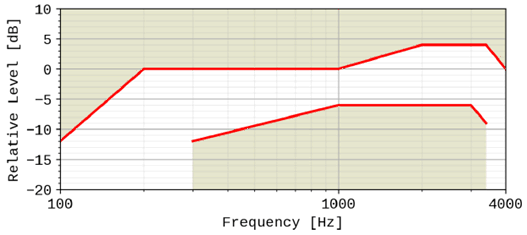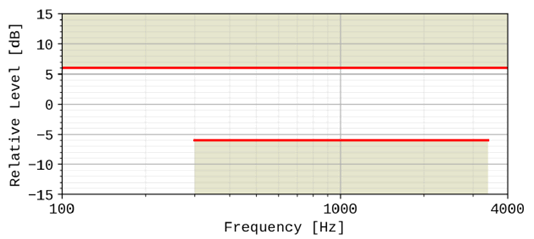Content for TS 26.131 Word version: 18.1.0
0…
5…
5.4…
5.4.3…
5.4.5…
5.4.7…
5.5…
5.8…
5.12…
6…
6.4…
6.4.3…
6.4.5…
6.4.7…
6.5…
6.8…
6.11…
6.12…
7…
7.4…
7.5…
7.8…
7.11…
7.12…
8…
8.4…
8.5…
8.8…
8.11…
8.12…
5.4 Sensitivity/frequency characteristics
5.4.1 Handset and headset UE sending
5.4.2 Handset and headset UE receiving
...
...
5.4 Sensitivity/frequency characteristics p. 17
5.4.1 Handset and headset UE sending p. 17
The sensitivity/frequency characteristics shall be as follows:
The sending sensitivity frequency response, measured either from the mouth reference point (MRP) to the digital interface or from the MRP to the SS audio output (digital output of the reference speech decoder of the SS), shall be within a mask, which can be drawn between the points given in Table 1. The mask is drawn with straight lines between the breaking points in Table 1 on a logarithmic (frequency) - linear (dB sensitivity) scale.
| Frequency (Hz) | Upper limit (dB) | Lower limit (dB) |
|---|---|---|
| 100 | -12 | |
| 200 | 0 | |
| 300 | 0 | -12 |
| 1 000 | 0 | -6 |
| 2 000 | 4 | -6 |
| 3 000 | 4 | -6 |
| 3 400 | 4 | -9 |
| 4 000 | 0 | |
|
NOTE:
All sensitivity values are expressed in dB on an arbitrary scale.
|
||

Compliance shall be checked by the relevant test described in TS 26.132.
5.4.2 Handset and headset UE receiving p. 18
The sensitivity/frequency characteristics shall be as follows:
The receiving sensitivity frequency response, measured either from the digital interface to the DRP with diffuse-field correction or from the SS audio input (analogue or digital input of the reference speech encoder of the SS) to the DRP with diffuse-field correction shall be within a mask, which can be drawn with straight lines between the breaking points in Table 2 on a logarithmic (frequency) - linear (dB sensitivity) scale.
| Frequency (Hz) | Upper limit (dB)
8 ± 2 N |
Lower limit (dB)
8 ± 2 N |
|---|---|---|
| 100 | 6 | |
| 300 | 6 | -6 |
| 3 400 | 6 | -6 |
| 4 000 | 6 | |
|
NOTE 1:
All sensitivity values are expressed in dB on an arbitrary scale
NOTE 2:
The basis for the target frequency responses in send and receive is the orthotelephonic reference response measured between 2 subjects 1 m apart under free-field conditions and assumes an ideal receive characteristic. Under these conditions the overall frequency response shows a rising slope. The present document no longer uses the ERP as the reference point for receive but the diffuse-field. With the concept of diffuse-field based receive measurements a rising slope for the overall frequency response is achieved by a flat target frequency response in send and a flat diffuse-field based receive frequency response.
|
||

Figure 2: Handset and headset receiving sensitivity/frequency mask for 8N application force
(⇒ copy of original 3GPP image)
(⇒ copy of original 3GPP image)
Compliance shall be checked by the relevant test described in TS 26.132.